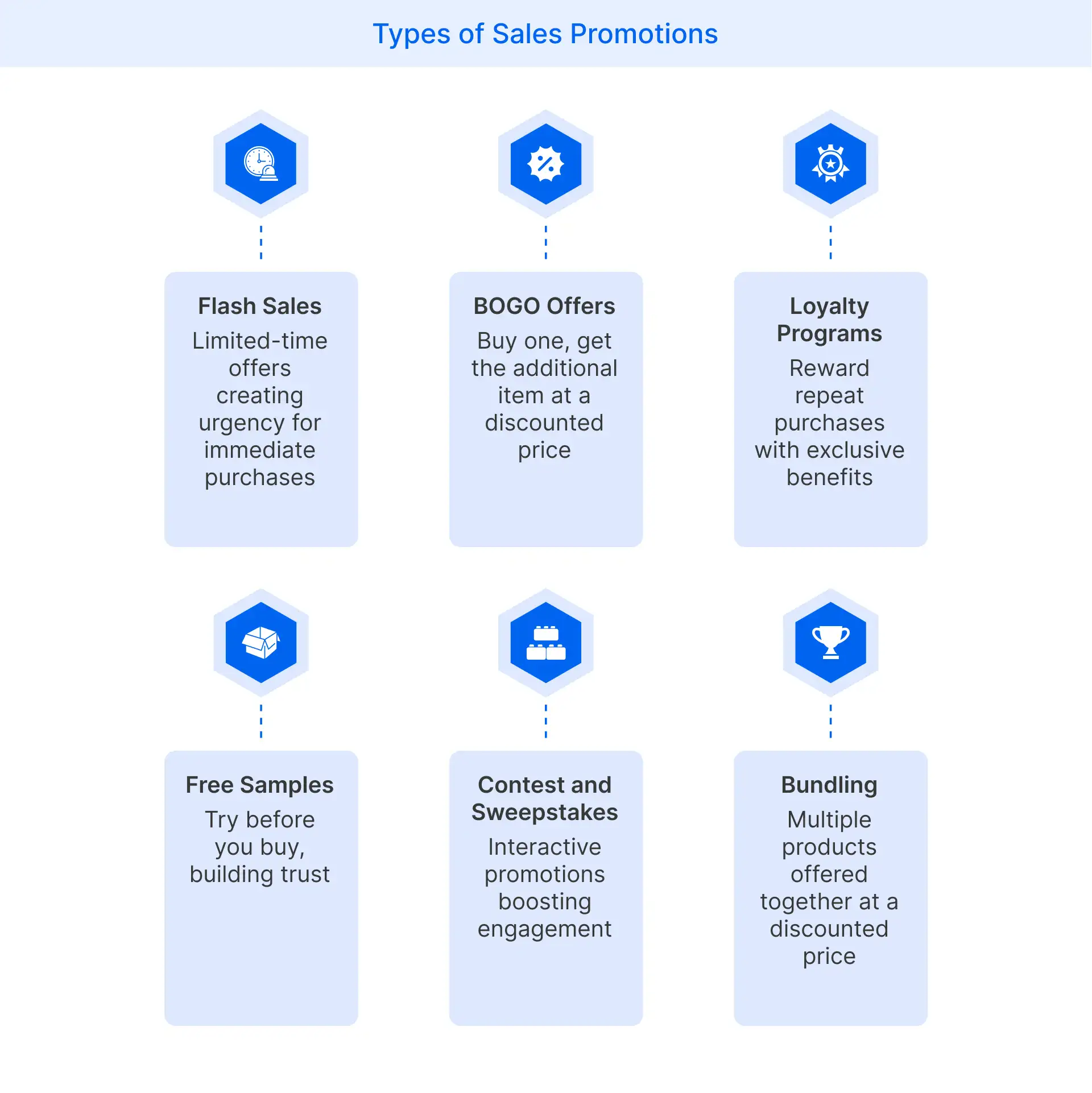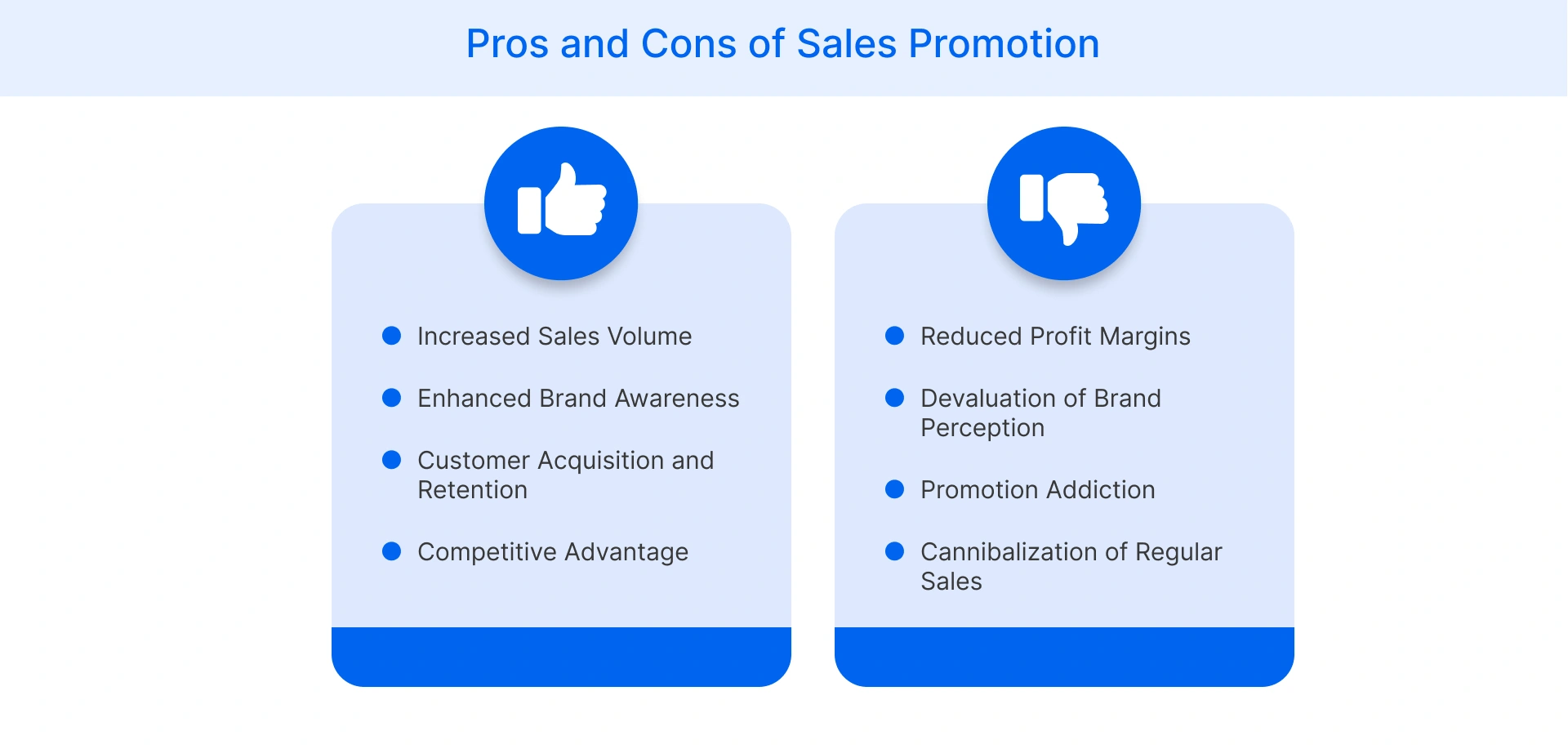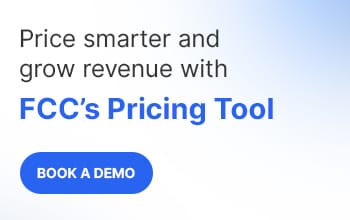Table of Contents
- What is a sales promotion?
- How does a sales promotion work?
- What are the types of sales promotions?
- What are the benefits of sales promotions?
- What are the cons of sales promotions?
- What are the different sales promotion strategies?
- Tips for building successful sales promotions
What is Sales Promotion?
Sales promotion is a marketing technique used to drive short-term consumer interest and increase sales through limited-time offers or value-based incentives. It serves as a tool to create urgency, influence purchasing behavior, and improve customer engagement across retail channels.
Businesses use sales promotions to highlight new products, clear seasonal inventory, or respond to competitive market dynamics. These initiatives can include discounts, special offers, loyalty rewards, or bundled deals. In the retail sector, sales promotion plays a key role in attracting foot traffic, enhancing brand recall, and converting potential buyers into paying customers within a shorter sales cycle.
How does a sales promotion work?
Sales promotions operate by creating a compelling reason for customers to act quickly. They leverage psychological principles to influence consumer behavior and drive immediate sales. By offering time-limited incentives, sales promotions tap into the fear of missing out (FOMO), encouraging customers to make purchase decisions faster than they normally would.
These promotions often combine attractive offers with targeted messaging to capture attention and generate excitement. They may highlight exclusive deals, emphasize limited availability, or showcase significant savings. The urgency created by these tactics motivates customers to take advantage of the offer before it expires.
Effective sales promotions also consider the customer journey, strategically placing offers at key decision-making points. This could involve showcasing promotions on product pages, during checkout, or through personalized email campaigns.
Sales Promotion Example
Flipkart, one of India's largest e-commerce platforms, runs an annual sales event called Big Billion Days. In 2024, this promotion ran from September 27th to October 6th, with Flipkart Plus members gaining early access on September 26th. The sale featured significant discounts across various product categories, including electronics, fashion, and home appliances.
To create urgency and drive sales, Flipkart employed strategies such as countdown timers on deal listings, limited-time offers, and exclusive product launches. The company also leveraged multi-channel marketing strategies, including TV commercials, digital advertising, public relations, and influencer partnerships, to maximize reach and engagement during the sale period.
What are the Types of Sales Promotions?
Here are some common types of sales promotion strategies used in retail and e-commerce:
Flash Sales
Flash sales create urgency by offering deals for a limited time, prompting immediate purchases. Flipkart’s ‘Big Billion Days’ is a prime example, offering significant discounts across multiple categories for a short period. This annual event, typically held in September-October, features countdown timers and exclusive deals to draw in a broad target audience to maximize engagement and sales.
Buy-One-Get-One (BOGO) Offers
BOGO deals encourage customers to purchase more by offering additional value. Flipkart often uses this strategy during festive seasons, such as Diwali or Christmas sales. For instance, they might offer a free accessory with smartphone purchases or a second clothing item at a discounted price, effectively increasing average order value. This type of sales promotion is highly effective for creating repeat business and customer loyalty.
Loyalty Programs
Loyalty programs foster long-term customer relationships by rewarding repeat purchases. Flipkart Plus, the platform’s loyalty program, offers benefits like early access to sales, free delivery, and exclusive deals. Members earn coins on purchases, which can be redeemed for additional discounts, enhancing customer retention and lifetime value.

Free Samples
Free samples allow customers to try products before committing to a purchase, building trust and interest. While less common in e-commerce, Flipkart incorporates this concept through ‘try and buy’ options for selecting fashion items, letting customers experience products before finalizing their purchase, reducing return rates and increasing customer satisfaction.
Contests and Sweepstakes
Interactive promotions like contests engage customers and boost brand visibility. During major sales events, Flipkart often runs social media contests or in-app games where participants can win prizes or exclusive discounts. These promotions increase user engagement and create buzz around the brand and its offerings.
Bundling
Bundling involves offering multiple products together at a discounted price, encouraging larger purchases. Flipkart frequently uses this strategy for electronics and home appliances. For example, they might bundle a smartphone with a case and screen protector at a lower combined price, providing value to customers while increasing average order value.
What are the Benefits of Sales Promotions?
Sales promotions offer numerous advantages for businesses looking to boost their market presence and drive revenue.
- Increased Sales Volume: Sales promotions stimulate immediate purchases, often resulting in a significant spike in sales during the promotional period. This quick boost in revenue can help businesses meet short-term financial goals and clear excess inventory.
- Enhanced Brand Awareness: Promotional activities attract attention to your brand and products, increasing visibility in the market. This heightened exposure can lead to long-term benefits, such as improved brand recall and customer acquisition.
- Customer Acquisition and Retention: Well-designed promotions can attract new customers to try your products or services. Additionally, loyalty-based promotions encourage repeat purchases, fostering long-term customer relationships and increasing customer lifetime value.
- Competitive Advantage: Strategic sales promotions can help you stand out in a crowded market. By offering unique or compelling deals, you can differentiate your brand from competitors and capture market share.
Cons of Sales Promotions
While sales promotions can be powerful marketing tools, they also come with potential drawbacks that businesses must carefully consider.
- Reduced Profit Margins: Frequent or deep discounts can erode profit margins, especially if not balanced with increased sales volume. This can lead to financial strain, particularly for businesses with slim profit margins.
- Devaluation of Brand Perception: Excessive promotions may lead customers to perceive your brand as low-quality or discount-dependent. This can make it challenging to sell products at full price and diminish overall brand value.
- Promotion Addiction: Customers may become accustomed to buying only during promotional periods, leading to decreased sales during non-promotional times. This behavior can create a cycle of dependency on promotions to drive sales.
- Cannibalization of Regular Sales: Promotions can sometimes cannibalize full-price sales, merely shifting the timing of purchases rather than generating additional revenue. This can disrupt normal sales patterns and inventory management.

What are the different sales promotion strategies?
Sales promotion strategies are broadly classified into push, pull, and hybrid approaches. Let’s understand how these strategies can help businesses structure their promotional efforts:
- Push Strategy: It focuses on incentivizing intermediaries in the distribution channel to promote products to end consumers. Push strategy includes offering trade allowances, organizing sales contests for retail staff, and providing point-of-purchase displays. By motivating channel partners, businesses increase product visibility and availability, ultimately driving sales to end consumers.
- Pull Strategy: This strategy aims to create demand directly from consumers, drawing them towards the product. This approach typically involves consumer-focused promotions such as discounts, rebates, or loyalty rewards. Pull strategies often leverage mass media advertising, social media campaigns, and influencer partnerships to generate buzz and interest, compelling retailers to stock and promote the item.
- Hybrid Strategy: This approach combines elements of both push and pull approaches, creating a comprehensive sales promotion plan. This balanced method aligns incentives for both channel partners and end consumers, maximizing the reach and effectiveness of the promotion. Hybrid strategies might include consumer rebates coupled with retailer incentives or social media campaigns supported by in-store promotions.
Tips for building successful sales promotions
Here are key best practices to ensure your promotional efforts drive results and align with business objectives:
- Set clear and measurable goals for your sales promotion, such as increasing sales volume by a specific percentage or acquiring a target number of new customers.
- Identify and target the right audience segment for your promotion, ensuring your offer resonates with their needs, preferences, and purchasing behaviors.
- Implement time-limited offers or highlight limited stock availability to create a sense of urgency and encourage immediate action from potential customers.
- Leverage multiple marketing channels, including social media, email marketing, and in-store displays, to maximize the reach and impact of your sales promotion.
- Continuously monitor promotion performance using key metrics and be prepared to make real-time adjustments to optimize results and ROI.
Conclusion
Sales promotion plays a vital role in influencing buyer behavior, improving product visibility, and supporting short-term sales goals in retail environments. It allows businesses to respond swiftly to market trends, attract new customers, and clear inventory efficiently. By combining strategic planning with targeted execution, sales promotion becomes an effective tool for driving conversions and supporting broader pricing strategies. When implemented thoughtfully, it enhances brand presence and contributes to sustainable retail success.
FAQ
While sales promotions can drive short-term sales, overuse may negatively impact brand perception. Frequent discounting can devalue products and create a discount-dependent customer base. To maintain brand integrity, balance promotional activities with value-added offers and focus on quality and unique selling propositions.
Sales promotions can significantly boost customer retention by offering exclusive deals to loyal customers and encouraging repeat purchases. They can reactivate dormant customers, increase purchase frequency, and enhance overall customer lifetime value. Well-designed loyalty programs and personalized offers are particularly effective for retention.
Key metrics for evaluating sales promotions include sales volume, revenue growth, conversion rates, and customer acquisition costs. Also, track average order value, redemption rates for coupons or discounts, and changes in market share. Monitor customer engagement metrics like website traffic and social media interactions.
The duration of a sales promotion depends on its objectives and type. Short-term promotions (1-7 days) create urgency, while longer campaigns (2-4 weeks) can build sustained interest. Seasonal promotions may last several months. Always consider your product lifecycle and customer behavior when determining length.

